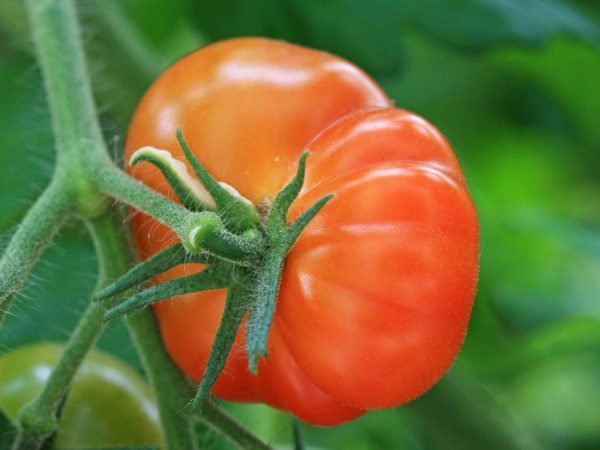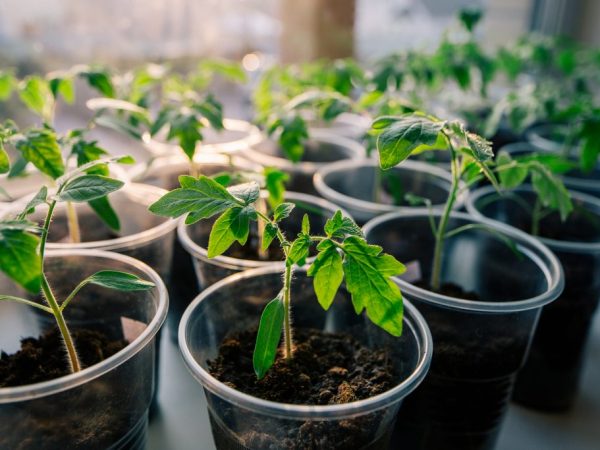Tomato variety Tsar's gift
Due to its unpretentiousness and high taste, the Tsar's gift tomato is considered the most popular among gardeners. Tomatoes Tsar's gift belong to large-fruited varieties of salad variety.

Tomato variety Tsar's gift
Due to the high sugar content, the fruits have a pronounced rich taste. The variety is unpretentious in care, easily adapts to cold weather. Despite the volumetric size of the fruit, the bushes are quite compact. The variety is suitable for growing both in greenhouses and in the open field.
Tomato of the Tsarsky Gift variety was produced in Russia.
Description of the variety
The tomato bush of the Tsarsky Gift variety reaches a height of 1 m. The shape of the bush is round-barrel. The leaves are dark green. Ripe fruits are bright red in color and medium in size. The stems are thick and dense. When ripe, the skin and flesh are also firm. tomato has a small amount of seeds, but it has excellent, pronounced taste.
Vegetables are dense enough so that they can be taken over long distances.
According to the description, the average weight of a tomato is 220 g, in rare cases - 500 g. Tomato variety Tsar's gift has a high yield, reaching up to 8 kg per 1 sq. M. m. These tomatoes are great for growing for sale.
Benefits of the variety
Among the advantages of the Tsarsky Gift variety, the following characteristics are noted:
- rich taste;
- transportability;
- versatility;
- resistance to fusarium and verticillium;
Beneficial features
The royal gift includes a number of substances and vitamins useful for humans: vitamins C, B1, B2, B5, as well as potassium, calcium, magnesium, iron, zinc, iodine, folic acid.
Cons of the variety
The royal gift also has a number of disadvantages:
- with high humidity, the fruits crack;
- fruits are not suitable for conservation;
- the variety is dependent on weather conditions;
- tomatoes are susceptible to fungal infections.
Growing
Tomatoes are great for growing in seedlings. Before sowing, seeds and soil are treated to prevent infection and spread of infection throughout all plantings. The soil includes earth, humus and peat. The seeds are sown to a depth of about 2 cm, then covered with foil and placed in a warm, lighted place.
Sprouts are watered with warm water. After the appearance of the first leaves, the soil is fed with liquid fertilizer, which includes nitrogen. This method is used for fast growth and better plant survival.
A week before transplanting, the plant is taken out daily to fresh air: this helps it get used to the weather conditions.
The transplant is carried out at the beginning of June. Before this, the soil is well cultivated and fertilized. A distance of 60 cm is maintained between the plants.
Warm water is used for irrigation. Planting is watered regularly, in the evening.

Plants are fertilized regularly
The soil is loosened so that moisture reaches the roots faster, and does not stagnate in one place. Water should not come into contact with the leaves.
The plantings are fertilized, since the tomato cannot constantly take the necessary elements from the soil. During the season, tomatoes are fed about 3-4 times. Foliar dressing is also carried out, but not more often than once every 10 days. Combination with pest control is possible. In order not to overdo it with fertilizers, dressing is added in smaller quantities.
Diseases of tomatoes
To protect plantings, ventilate the greenhouse and create a kind of ventilation.
The plant most often does not have time to become infected with common diseases and pests, as it belongs to the early maturing.
To prevent diseases, the soil is treated with a solution of potassium permanganate before planting.
Diseases
The Tsar's gift variety affects a number of ailments:
- Fusarium. The cause of the disease is soil oversaturation with nitrogen. If the tomatoes are infected with fusarium, there is no point in saving the planting, you should immediately get rid of the affected bushes.
- Root rot. This disease occurs with high soil moisture. To prevent infection, tomatoes are watered only when the soil dries out.
- Viral diseases. Diseased plants are removed, since there is no cure for the disease.
- Necrosis. It occurs due to insufficient illumination of plantings or excessive watering. The disease destroys the surface of the fruit, forming holes. Plantings are treated with phytosporin or a similar drug that prevents the appearance of fungal diseases.
Pests
Young tomatoes are prone to destruction by larvae and insect pests, so the sprouts must be carefully inspected. Most often, the Tsar's gift amazes:
- Aphid. Get rid of it with a soapy solution.
- Spider mite. This insect is small and feeds on leaf sap. Pests can be seen on the back of the foliage, they usually live in entire colonies. To get rid of the pest, the leaves are wiped with soapy water, dandelion infusion or irradiated with ultraviolet light.
- Whitefly. It is a larva that feeds on plant sap. Whiteflies are treated with insecticides.
- Medvedka. One of the most dangerous pests. She is able to even get into the greenhouse. The pest lays eggs, from which larvae appear quite quickly, feeding on the roots of the plant.
Growing a tomato of this variety is possible in any climate, the main thing is the correct and timely care of the plantings. The variety provides a stable high yield, resistant to cold.


